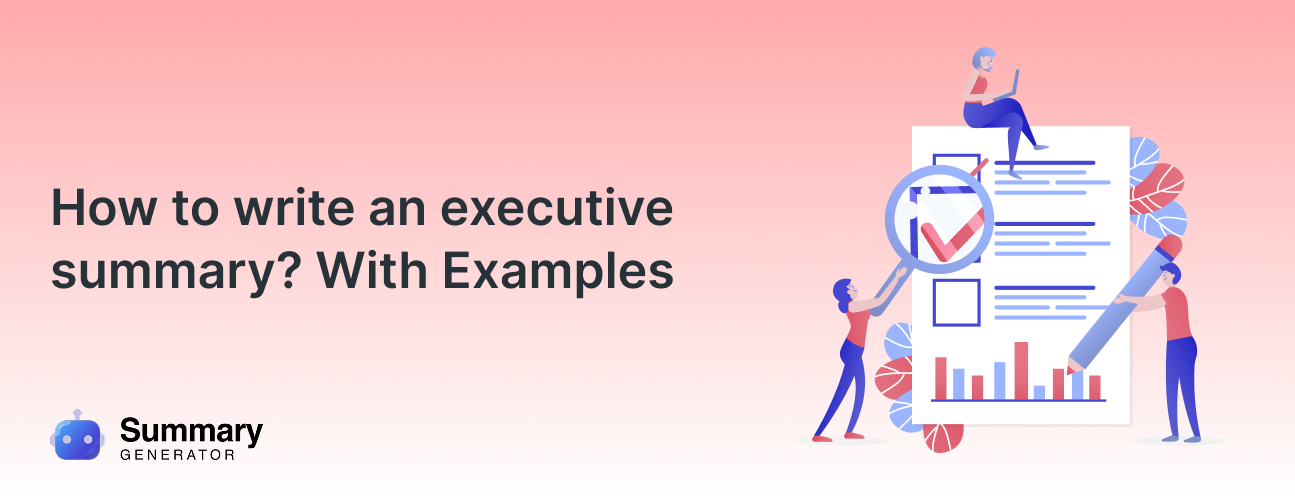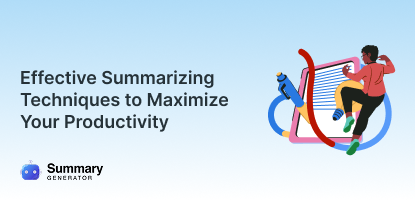Every long report, proposal, or business plan needs a doorway that pulls readers in. That doorway is the executive summary. It decides if someone keeps reading or closes the file.
Although it’s very important, this one-page or two-page section is where most people stumble. Some copy-paste the introduction. Others cram in numbers without explanation. A few try to impress with technical jargon. The result? They create a summary that looks official but fails to persuade.
Here, we will share some helpful tips to write an executive summary with examples. It will surely improve your summarizing skills. Before that, let’s discuss some important things!
What to Include in an Executive Summary
- Purpose: What the document is about or why it was written.
- Problem or Opportunity: What issue the project solves or what chance it captures.
- Method or Approach: A short line on how you analyzed or structured your work.
- Key Findings: What you discovered, the headline results.
- Recommendations: The steps or solutions you propose.
- Impact or Benefits: What changes if your plan is adopted.
- Action needed: What decision you want from the reader.
That’s the structure. But structure alone doesn’t win buy-in. The writing does. That’s where the following tips matter.
10 Tips for Writing a Strong Executive Summary
1. Write It Last, Even Though It Appears First
The order of writing and the order of appearance are different. Always finish the full report before touching the executive summary. Why? Because until you know which findings stand strongest, you can’t be sure what to highlight. Drafting too early leads to half-truths or outdated details.
When you write it last, you know which numbers matter, which recommendations survived editing, and which ideas you dropped. This keeps your summary accurate and aligned with the final report.
Example:
You draft a summary after the first version of a marketing report, saying the company should focus on social media ads. Later, your deeper analysis shows influencer partnerships yield twice the ROI. If you had waited, your summary would have reflected the stronger recommendation and avoided contradiction.
2. Keep It Short, but Don’t Strip It Bare
Length is a balancing act. Too long, and no one reads it. Too short, and it loses meaning. The sweet spot is usually one page for short reports, up to three for major plans. The point is to give someone enough to understand the project without flipping pages.
However, being short doesn’t mean vague. In fact, every sentence should add value to the content. Just cut the background fluff, but keep the insights that matter.
Example:
Weak:
“We conducted several interviews and surveys to understand the market situation in different cities.”
Better:
“Interviews with 200 customers across three cities showed that price sensitivity, not product quality, is the top barrier to purchase.”
Have a look at both examples. The second version communicates a clear insight because it didn’t cut the actual information.
3. Start With the Big Idea
Many people waste the opening by talking about the process or background. That’s a mistake. You need to grab attention with the one thing that matters most: the headline insight or recommendation. Executives skim, and they often stop after the first paragraph. So, don’t hide your strongest point. Instead, state it immediately.
For that, ask yourself: if the reader only remembers one thing, what should it be? Put that sentence at the top.
Example:
Poor start:
“This document looks at our distribution operations and explores several improvement opportunities.”
Strong start:
“Outsourcing last-mile delivery will reduce costs by 20 percent within the first year.”
One opening wanders, and the other commands attention. And that’s the difference between a poor and a strong start.
4. Skip the Technical Overload
Most people don’t need to know about algorithms, frameworks, or systems in detail. If your summary sounds like a technical manual, you’ve already lost them. Remember, your job is to translate complexity into clear outcomes. So, save the jargon for appendices.
Example:
Technical:
“The infrastructure relies on containerized microservices deployed on Kubernetes for automated scaling.”
Accessible:
“The system automatically scales when traffic increases, ensuring reliability and reducing downtime.”
Both have the same meanings. But the second version is easy to read for everyone.
5. Talk About Results, Not Steps
Readers don’t care how many spreadsheets you ran or what models you used. They care about what those steps revealed. Methodology matters, but it belongs in the main report. However, the summary should always spotlight results and implications.
Example:
Method-focused:
“Our team applied regression analysis to five years of transaction data across multiple categories.”
Result-focused:
“Analysis shows repeat buyers drive 70 percent of profits, making loyalty programs more effective than customer acquisition campaigns.”
The second version is the one that earns support.
6. Use Numbers That Matter
Numbers make recommendations stronger, but drowning a summary in data overwhelms readers. The trick is to choose the few that really carry weight. For instance, you can highlight financial impact, percentages, growth potential, or savings and round them where you can.
Example:
Overload:
“We analyzed 10,274 transactions, 3,215 customer calls, and 417 product returns.”
Impactful:
“Faster response times could increase annual revenue by $3 million.”
Readers remember impact, not raw counts.
7. Make It Persuasive, Not Just Informative
A summary isn’t neutral. It’s written to convince someone to act. That means you must present your recommendations as urgent, valuable, and worth attention. To ensure that, avoid soft language like “might” or “possibly.” Instead, talk with confidence.
Example:
Flat:
“This project could improve satisfaction levels.”
Persuasive:
“Without this project, churn will rise by 10 percent next year. Approving it now protects revenue and strengthens customer loyalty.”
Compare both examples. The first one lacks confidence and is vague. Whereas the second example doesn’t just report, it persuades.
8. Match the Audience
One summary won’t fit all readers. Tailor it to the people making the decision. Investors want to see growth and return. Regulators want compliance and risk reduction. Internal executives want efficiency and competitive advantage. Before you write an executive summary, always know who you are writing for. Then, match tone and content according to them.
Example:
Investor-focused:
“This plan delivers a 28 percent return within three years.”
Regulator-focused:
“This plan cuts emissions by 15 percent annually, exceeding compliance standards.”
Look: same plan but different emphasis. That’s what tailoring looks like.
9. Edit Harder Than You Think Necessary
A rushed summary is a red flag. Even if the report itself is solid, typos, vague language, or clutter in the summary cast doubt. For executive summaries, strong editing is non-negotiable. During the editing phase, cut unnecessary words, replace vague claims with concrete ones, and ensure the call to action is unmistakable.
Example:
Weak:
“This project could provide positive outcomes over time.”
Edited:
“This project reduces costs by $1.2 million a year and pays back its investment in under 24 months.”
The edited version is sharper, measurable, and far more convincing.
10. Use an Advanced Summary Generator
A blank page slows many people down. When the report is long and the deadline is tight, a summary generator can break the logjam. By generating a distilled version of the full text, you can create your working draft of the executive summary. The value isn’t in copying it word-for-word but in using it as a foundation. You still bring in the nuance, tone, and persuasion that no tool can provide.
Example:
Say your financial plan runs 40 pages. Feeding it into a summarizer might highlight revenue growth, risk exposure, and investment needs in a single paragraph. You then expand each point, connect it to recommendations, and tailor it for decision-makers.
Mistakes That Kill an Executive Summary
Even experienced professionals make missteps. The most damaging include:
- Copying the introduction instead of writing a stand-alone summary
- Overloading with technical terms or data tables
- Using vague promises with no numbers
- Ignoring the audience’s priorities
- Forgetting a clear ask or call to action
- Presenting a wall of text with no breaks
- Skipping the editing stage
Any of these errors weakens credibility, no matter how strong the report behind it.
Conclusion
An effective executive summary makes your work accessible. It doesn’t replace the report, but it should allow someone to grasp the essentials without needing to flip a single page further. Think of it as a professional filter: it sifts out the noise and leaves behind what the reader cannot ignore.



